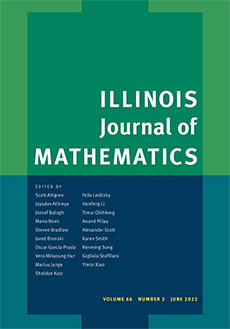Abstract
Let $\mathcal{S}$ be a finite generalized quadrangle of order $(s,t)$, $s \ne 1 \ne t$. A spread is a set of $st + 1$ mutually non-concurrent lines of $\mathcal{S}$. A spread $\mathbf{T}$ of $\mathcal{S}$ is called a spread of symmetry if there is a group of automorphisms of $\mathcal{S}$ which fixes $\mathbf{T}$ elementwise and which acts transitively on the points of at least one (and hence every) line of $\mathbf{T}$. From spreads of symmetry of generalized quadrangles, there can be constructed near polygons, and new spreads of symmetry would yield new near polygons. In this paper, we focus on spreads of symmetry in generalized quadrangles of order $(s,s^2)$. Many new characterizations of the classical generalized quadrangle $\mathcal{Q}(5,q)$ which arises from the orthogonal group $\mathbf{O}^{-}(6,q)$ will be obtained. In particular, we show that a generalized quadrangle $\mathcal{S}$ of order $(s,t)$, $s \ne 1 \ne t$, containing a spread of symmetry {\bf T} is isomorphic to $\mathcal{Q}(5,s)$, under any of the following conditions:
(i) $\mathcal{S}$ contains a point which is incident with at least three axes of symmetry (Theorem 6.4);
(ii) $t = s^2$ with $s$ even and $\mathcal{S}$ has a center of transitivity (Theorem 6.6);
(iii) there exists a line $L \not\in \mathbf{T}$ such that $\mathcal{S}$ is an EGQ with base-line $L$ (Theorem 6.8).
Citation
Bart De Bruyn. Koen Thas. "Generalized quadrangles with a spread of symmetry and near polygons." Illinois J. Math. 46 (3) 797 - 818, Fall 2002. https://doi.org/10.1215/ijm/1258130985
Information





